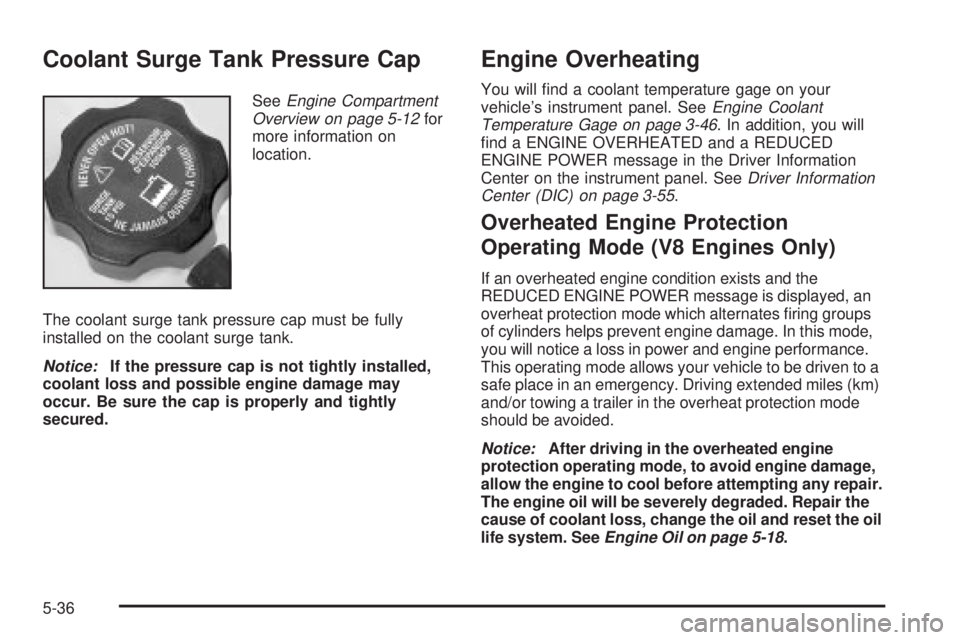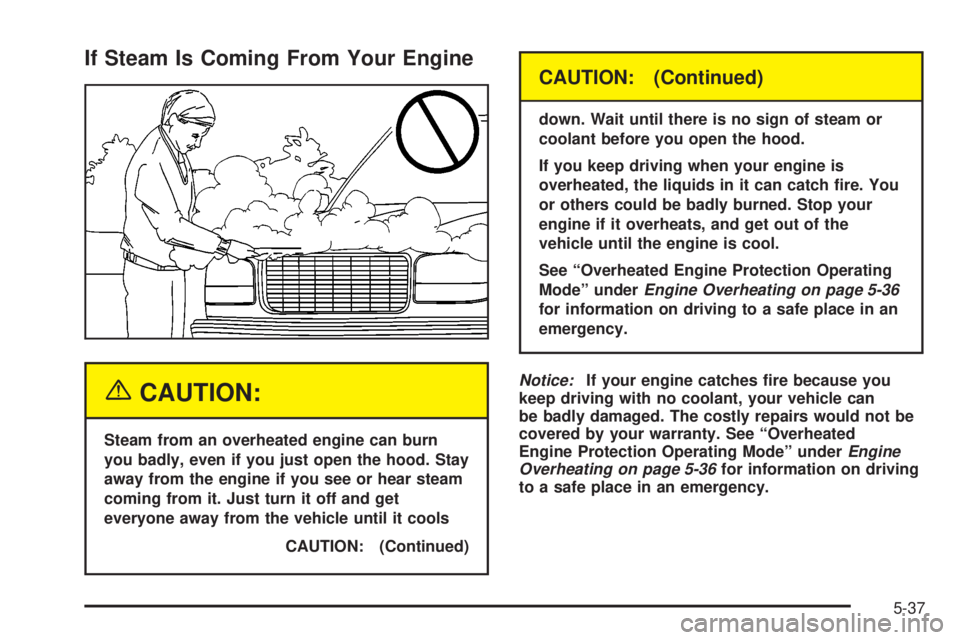Page 433 of 588

How to Check and Add Fluid
The proper ¯uid should be added if the level does not
reach the bottom of the diaphragm when it's in place in
the reservoir. See the instructions on the reservoir cap.
Engine Coolant
The cooling system in your vehicle is ®lled with
DEX-COOLžengine coolant. This coolant is designed
to remain in your vehicle for 5 years or 150,000 miles
(240 000 km), whichever occurs ®rst, if you add only
DEX-COOL
žextended life coolant.
The following explains your cooling system and how to
add coolant when it is low. If you have a problem
with engine overheating, see
Engine Overheating on
page 5-36.A 50/50 mixture of clean, drinkable water and
DEX-COOL
žcoolant will:
·Give freezing protection down to-34ÉF (-37ÉC).
·Give boiling protection up to 265ÉF (129ÉC).
·Protect against rust and corrosion.
·Help keep the proper engine temperature.
·Let the warning lights and gages work as they
should.
Notice:Using coolant other than DEX-COOLžmay
cause premature engine, heater core or radiator
corrosion. In addition, the engine coolant may
require changing sooner, at 30,000 miles (50 000 km)
or 24 months, whichever occurs ®rst. Any repairs
would not be covered by your warranty. Always use
DEX-COOL
ž(silicate-free) coolant in your vehicle.
5-33
Page 436 of 588

Coolant Surge Tank Pressure Cap
SeeEngine Compartment
Overview on page 5-12for
more information on
location.
The coolant surge tank pressure cap must be fully
installed on the coolant surge tank.
Notice:If the pressure cap is not tightly installed,
coolant loss and possible engine damage may
occur. Be sure the cap is properly and tightly
secured.
Engine Overheating
You will ®nd a coolant temperature gage on your
vehicle's instrument panel. SeeEngine Coolant
Temperature Gage on page 3-46. In addition, you will
®nd a ENGINE OVERHEATED and a REDUCED
ENGINE POWER message in the Driver Information
Center on the instrument panel. See
Driver Information
Center (DIC) on page 3-55.
Overheated Engine Protection
Operating Mode (V8 Engines Only)
If an overheated engine condition exists and the
REDUCED ENGINE POWER message is displayed, an
overheat protection mode which alternates ®ring groups
of cylinders helps prevent engine damage. In this mode,
you will notice a loss in power and engine performance.
This operating mode allows your vehicle to be driven to a
safe place in an emergency. Driving extended miles (km)
and/or towing a trailer in the overheat protection mode
should be avoided.
Notice:After driving in the overheated engine
protection operating mode, to avoid engine damage,
allow the engine to cool before attempting any repair.
The engine oil will be severely degraded. Repair the
cause of coolant loss, change the oil and reset the oil
life system. See
Engine Oil on page 5-18.
5-36
Page 437 of 588

If Steam Is Coming From Your Engine
{CAUTION:
Steam from an overheated engine can burn
you badly, even if you just open the hood. Stay
away from the engine if you see or hear steam
coming from it. Just turn it off and get
everyone away from the vehicle until it cools
CAUTION: (Continued)
CAUTION: (Continued)
down. Wait until there is no sign of steam or
coolant before you open the hood.
If you keep driving when your engine is
overheated, the liquids in it can catch ®re. You
or others could be badly burned. Stop your
engine if it overheats, and get out of the
vehicle until the engine is cool.
See ªOverheated Engine Protection Operating
Modeº under
Engine Overheating on page 5-36
for information on driving to a safe place in an
emergency.
Notice:If your engine catches ®re because you
keep driving with no coolant, your vehicle can
be badly damaged. The costly repairs would not be
covered by your warranty. See ªOverheated
Engine Protection Operating Modeº under
Engine
Overheating on page 5-36for information on driving
to a safe place in an emergency.
5-37
Page 476 of 588

Tires
Your new vehicle comes with high-quality tires made by
a leading tire manufacturer. If you ever have questions
about your tire warranty and where to obtain service,
see your GM Warranty booklet for details. For additional
information refer to the tire manufacturer's booklet
included with your vehicle's Owner's Manual.
{CAUTION:
Poorly maintained and improperly used tires
are dangerous.
·Overloading your tires can cause
overheating as a result of too
muchfriction. You could have an air-out
and a serious accident. See ªLoading Your
Vehicleº in the Index.
CAUTION: (Continued)
CAUTION: (Continued)
·
Underin¯ated tires pose the same danger
as overloaded tires. The resulting accident
could cause serious injury. Check all tires
frequently to maintain the recommended
pressure. Tire pressure should be checked
when your tires are cold.
·Overin¯ated tires are more likely to be
cut, punctured or broken by a sudden
impact Ð such as when you hit a pothole.
Keep tires at the recommended pressure.
·Worn, old tires can cause accidents. If
your tread is badly worn, or if your tires
have been damaged, replace them.
Tire Sidewall Labeling
Useful information about a tire is molded into the
sidewall. The following illustrations are examples of a
typical P-Metric and a LT-Metric tire sidewall.
5-76
Page 576 of 588

Electrical System (cont.)
Fuses and Circuit Breakers.........................5-126
Power Windows and Other Power Options....5-126
Windshield Wiper Fuses.............................5-126
Electronic Transfer Case..................................2-44
Emissions Inspection and Maintenance
Programs...................................................3-51
Engine
Air Cleaner/Filter.........................................5-23
Battery.......................................................5-52
Check and Service Engine Soon Light............3-49
Coolant......................................................5-33
Coolant Heater............................................2-25
Coolant Temperature Gage...........................3-46
Engine Compartment Overview......................5-12
Exhaust.....................................................2-53
Fan Noise..................................................5-44
Oil .............................................................5-18
Overheating................................................5-36
Starting......................................................2-23
ENGINE COOLANT HOT.................................3-68
Engine Hour Meter Display...............................3-35
Engine Oil Additives........................................5-21
ENGINE OVERHEATED..................................3-68
Entertainment System
Cleaning the Video Screen..........................3-131
DVD Distortion..........................................3-129
Entry Lighting.................................................3-19
Environmental Concerns..................................4-24
Event Data Records (EDR)..............................7-10Exit Lighting...................................................3-19
Express Down Windows..................................2-17
Extended Cab................................................1-58
Extended Cab and Crew Cab...........................1-55
Extender, Safety Belt.......................................1-32
Exterior Lamps...............................................3-14
F
Fifth Wheel and Gooseneck Trailering................4-90
Filter
Engine Air Cleaner......................................5-23
Finding a Program Type (PTY) Station
(RDS and XMŸ).......................3-80, 3-92, 3-105
Finding a Station..................3-75, 3-78, 3-90, 3-103
Finish Care..................................................5-120
Finish Damage.............................................5-122
Five-Speed (VORTECŸ 4300 V6 and
4800 V8 Engines)........................................2-31
Five-Speed (VORTECŸ 6000 V8 Engine)...........2-30
Fixed Mast Antenna.......................................3-131
Flash-to-Pass................................................... 3-9
Flat Tire........................................................5-95
Flat Tire, Changing.........................................5-96
Fluid
Automatic Transmission........................5-25, 5-28
Manual Transmission....................................5-31
Power Steering...........................................5-45
6